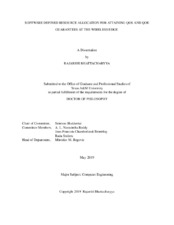| dc.contributor.advisor | Shakkottai, Srinivas | |
| dc.creator | Bhattacharyya, Rajarshi | |
| dc.date.accessioned | 2019-10-15T16:04:50Z | |
| dc.date.available | 2021-05-01T12:35:25Z | |
| dc.date.created | 2019-05 | |
| dc.date.issued | 2019-01-29 | |
| dc.date.submitted | May 2019 | |
| dc.identifier.uri | https://hdl.handle.net/1969.1/184387 | |
| dc.description.abstract | Wireless Internet access has brought legions of heterogeneous applications all sharing the same resources. However, current wireless edge networks that provide Quality of Service (QoS) guar-antees that only cater to worst or average case performance lack the agility to best serve these diverse sessions. Simultaneously, software reconfigurable infrastructure has become increasingly mainstream to the point that dynamic per packet and per flow decisions are possible at multiple layers of the communications stack. In this dissertation, we explore several problems in the space of cross-layer optimization of reconfigurable infrastructure with the objective of maximizing user-perceived Quality of Experience (QoE) under the resource constraints of the Wireless Edge.
We first model the adaptive reconfiguration of system infrastructure as a Markov Decision Pro-cess with a goal of satisfying application requirements, and whose transition kernel is discovered using a reinforcement learning approach. Our context is that of reconfigurable (priority) queueing, and we use the popular application of video streaming as our use case. Self declaration of states by all participating applications is necessary for the success of the approach. This need motivates us to design an open market-based system which promotes the truthful declaration of value (state). We show in an experimental setup that the benefits of such an approach are similar to those of the learning approach. Implementations of these techniques are conducted on off-the-shelf hardware, which have inherent restrictions on reconfigurability across different layers of the network stack. Consequently, we exploit a custom hardware platform to achieve finer grained reconfiguration capabilities like per packet scheduling and develop a platform for implementation and testing of scheduling protocols with ultra-low latency requirements. Finally, we study a distributed approach for satisfying strict application requirements by leveraging end user devices interested in a shared objective. Such a system enables us to attain the necessary performance goals with minimal use of centralized infrastructure. | en |
| dc.format.mimetype | application/pdf | |
| dc.language.iso | en | |
| dc.subject | Wireless communication networks | en |
| dc.subject | software reconfigurable infrastructure | en |
| dc.subject | online learning | en |
| dc.title | Software Defined Resource Allocation for Attaining QoS and QoE Guarantees at the Wireless Edge | en |
| dc.type | Thesis | en |
| thesis.degree.department | Electrical and Computer Engineering | en |
| thesis.degree.discipline | Computer Engineering | en |
| thesis.degree.grantor | Texas A & M University | en |
| thesis.degree.name | Doctor of Philosophy | en |
| thesis.degree.level | Doctoral | en |
| dc.contributor.committeeMember | Reddy, A.L. Narasimha | |
| dc.contributor.committeeMember | Chamberland-Tremblay, Jean Francois | |
| dc.contributor.committeeMember | Stoleru, Radu | |
| dc.type.material | text | en |
| dc.date.updated | 2019-10-15T16:04:50Z | |
| local.embargo.terms | 2021-05-01 | |
| local.etdauthor.orcid | 0000-0002-8354-2248 | |


